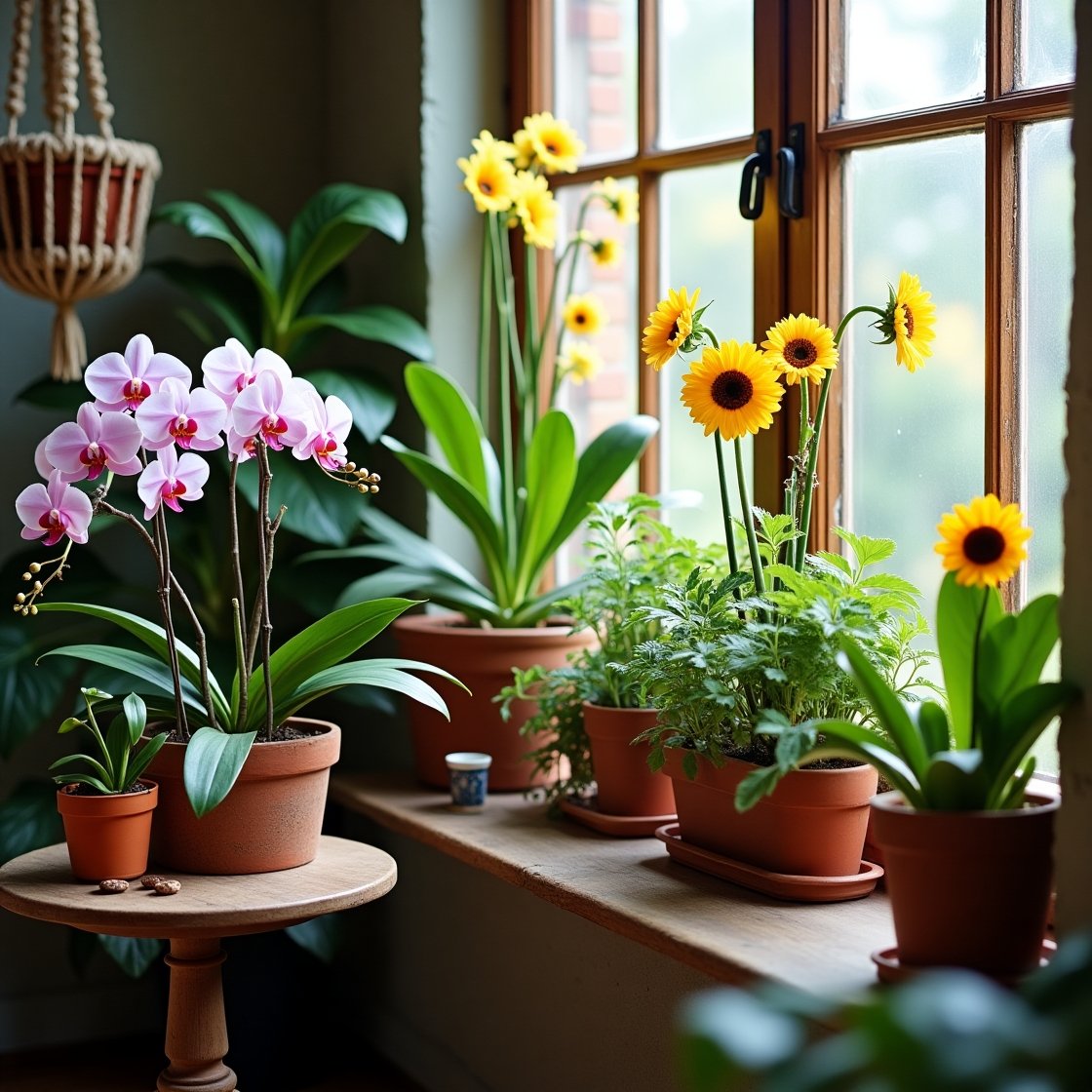When it comes to home decor, few elements offer the instant lift and energy of colorful plants. While leafy green houseplants are great for creating a calming, natural atmosphere, flowering plants like orchids, sunflowers, and anthuriums bring in bright pops of color that energize the space, elevate mood, and act as natural decor accents.
In this article, we’ll explore how to decorate various rooms using vibrant, blooming plants — from the elegance of orchids in minimalist spaces to cheerful sunflowers in rustic kitchens.
Why Add Colorful Plants to Your Decor?
Incorporating blooming plants into your interiors does more than just make a room look beautiful — it makes the entire space feel alive and emotionally charged. Here’s why they work:
- 🌸 Orchids: Symbolize luxury, calm, and refinement.
- 🌻 Sunflowers: Bring optimism, brightness, and warmth.
- ❤️ Anthuriums: Offer bold structure and a splash of passionate red.
- 💜 African Violets and Peace Lilies: Soft, inviting colors for more intimate spaces.
These plants can:
- Act as natural centerpieces
- Brighten darker rooms
- Add personality and mood to neutral color palettes
- Enhance the thematic cohesion of specific decor styles
How to Choose the Right Colorful Plant for Each Room
Every room has a different function and atmosphere, so the choice of plant should match both the mood you want to create and the care conditions available.
1. Living Room: Center of Attention
Best Colorful Plants: Orchids, Guzmanias, Anthuriums
Position blooming plants on a coffee table, side console, or near a bright window where their color becomes the focal point. Use white or neutral pots to let the color stand out without clashing with other decor elements.
2. Kitchen: Fresh & Vibrant
Best Colorful Plants: Sunflowers (cut flowers or dwarf varieties), African Violets, Kalanchoes
In kitchens with good natural light, vibrant flowers make the space feel homey and welcoming. A pot of yellow kalanchoes on the windowsill can boost both color and joy.
3. Bathroom or Lavabo: Minimalist and Moisture-Loving
Best Colorful Plants: Orchids (Phalaenopsis), Peace Lily
Bathrooms often have higher humidity — perfect for orchids. A single orchid on the sink counter or above the toilet tank adds an elegant and calming spa feel.
4. Bedroom: Calm with a Touch of Color
Best Colorful Plants: Lavender (if near a window), Peace Lily, Anthurium
Opt for mild tones and soft fragrances in bedrooms. Avoid overly bright reds or yellows if you’re aiming for a sleep-friendly space.
5. Corporate or Work Spaces: Boost Focus and Positivity
Best Colorful Plants: Anthuriums, Flamingo Flower, Mini Orchids
Red tones increase alertness and creativity. A small blooming plant on a work desk or meeting table adds life to typically sterile environments without distraction.
6. Baby Nursery: Gentle Colors and Safe Choices
Best Colorful Plants: African Violets, Mini Roses (non-toxic varieties), Chamomile in pots
Choose non-toxic plants with soft tones like lilac, light pink, and creamy whites. Make sure plants are placed out of reach of children and free of sharp edges or sap.
Color Theory and Plant Decor
Colorful plants can be used to complement or contrast with your room’s palette. Here’s how to do it right:
- Complementary contrast: Red anthuriums in green-themed rooms
- Analogous tones: Purple orchids in lavender-accented spaces
- Accent highlights: Bright yellow sunflowers in white kitchens
Pro tip: Use a color wheel to determine which flowering plant colors best match your furniture, walls, and textiles.
Seasonal Rotation of Colorful Plants
One way to keep your decor fresh and seasonally appropriate is by rotating flowering plants throughout the year:
- Spring: Hyacinths, Daffodils, Mini Tulips
- Summer: Sunflowers, Hibiscus, Gerbera Daisies
- Autumn: Chrysanthemums, Marigolds
- Winter: Poinsettias, Amaryllis, Orchids
This not only keeps your space interesting but can also create a celebratory or holiday atmosphere without relying solely on artificial decor.
Tips for Displaying Colorful Plants Effectively
- Use plant stands to elevate focal blooms.
- Place mirrors near bright flowers to double their presence.
- Use groupings: Combine colorful flowering plants with neutral green plants for balance.
- Don’t overdo it: One bold plant per space is often enough.
Care Considerations for Flowering Plants Indoors
These plants are beautiful — but they also require special attention to stay healthy and vibrant indoors.
Watering:
Most blooming plants need moist (not wet) soil. Overwatering leads to rot, especially in orchids.
Light:
- Orchids prefer bright, indirect light.
- Sunflowers need at least 6 hours of direct light (ideal as cut flowers in a vase).
- Anthuriums and violets enjoy medium indirect light.
Fertilization:
Use bloom-boosting fertilizers monthly to support flower production.
Humidity:
High humidity helps most tropical bloomers like orchids and anthuriums — consider a humidity tray or misting bottle.
Popular Decorative Styles Featuring Colorful Plants
- Bohemian: Clustered colorful plants in woven baskets or terracotta pots.
- Modern Minimalist: One bright bloom in a sleek white ceramic pot.
- Cottagecore: Sunflowers and daisies in mismatched vintage containers.
- Zen/Scandinavian: Orchids or peace lilies placed on low-profile wooden surfaces.
- Eclectic: Mix of unusual pots, shelves, and flowering plants across colors.
Final Thoughts: Let Color Bloom Naturally in Your Home
Colorful plants are more than a visual treat — they are mood lifters, conversation starters, and living art pieces. When placed with intention and care, plants like orchids, sunflowers, and anthuriums can transform your home into a vibrant and cozy sanctuary.
Whether you want a burst of energy in your kitchen, elegance in your office, or softness in your bedroom, there’s a blooming plant that fits the mood perfectly. Let nature do the decorating — colorfully.
